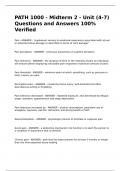PATH 1000 - Midterm 2 - Unit (4-7)
Questions and Answers 100%
Verified
Pain - ANSWER - "unpleasant sensory & emotional experience associated with actual
or potential tissue damage or described in terms of such damage"
Pain perception - ANSWER - conscious awareness of a painful sensation
Pain tolerance - ANSWER - the duration of time or the intensity of pain an individual
will endure before displaying noticeable pain responses (maximum amount of pain)
Pain threshold - ANSWER - minimum point at which something, such as pressure or
heat, causes you pain.
Nociceptive pain - ANSWER - caused by tissue injury, well-localized and often
described as aching or throbbing
Pain tolerance decreased - ANSWER - repeated exposure, also decreased by fatigue,
anger, boredom, apprehension and sleep deprivation
Pain tolerance increased by - ANSWER - alcohol consumption, persistent use of
analgesia, hypnosis, warmth, distraction and strong beliefs or faith
Neuromodulation - ANSWER - physiologic process to facilitate or suppress pain
Acute pain - ANSWER - a protective mechanism (its function is to alert the person to
a condition or experience that is harmful)
Chronic pain - ANSWER - pain that has been present for at least 3 months or longer
than the time expected tissue healing
,Acute somatic pain - ANSWER - arises from connective tissue, muscle, bone, &
tissue
Acute Visceral pain - ANSWER - pain arises from the internal organs & lining of body
cavities. Pain is poorly localized as a result of the fewer number of nociceptors
Depression - ANSWER - common for chronic pain
Specific or nonspecific back pain - ANSWER - many individuals of all ages have
chronic back pain
Fever - ANSWER - "a temporary resetting of the hypothalamic thermostat to a
higher level in response to endogenous or exogenous pyrogens"
Benefits of fever - ANSWER - helps the response to infectious processes, it helps kill
microorganisms, adversely affects the growth & replication of other microorganisms,
decrease serum levels or iron, zinc, & copper
Heat cramps - ANSWER - severe spasmodic cramps in the abdomen & extremities
that occur after prolonged sweating resulting in sodium lost (fever, tachycardia &
increased bp often occur)
Myofascial pain syndrome - ANSWER - injury to the muscle & fascia & tendons has
occurred (ex. spasm, tenderness, stiffness)
Chronic postoperative pain - ANSWER - changes in the PNS & CNS contribute to
allodynia & hypersensitivity
Cancer pain - ANSWER - pain results from the treatment for cancer or from the
cancer itself.
Phantom limb chronic pain - ANSWER - pain is felt in an amputated limb after the
stump has completely healed
, Neuralgia - ANSWER - chronic nerve pain
Peripheral neuropathic pain - ANSWER - injured nerves become hyperexcitable
Central neuropathic pain - ANSWER - is caused by a lesion or dysfunction in the
brain or spinal cord
Temperature regulation - ANSWER - achieved by balancing (heat production, heat
conservation, and heat loss)
Hypothalamic Control - ANSWER - peripheral thermoreceptors in the skin
Hypothalamus - ANSWER - receives information
Heat production - ANSWER - chemical reactions of metabolism, skeletal contraction,
and chemical thermogenesis
Mechanisms of Heat loss - ANSWER - radiation, conduction, convection, evaporation,
increased respiration, vasodilation, decreased muscle tone, voluntary measure,
adaptation to warm environment
Convection - ANSWER - when a stream of air (wind) is cooler than body surface
temp
Aging and temp - ANSWER - decreased vasoconstrictor response, decreased or
absent sweating, dyschronization or circadian rhythm, under nutrition, decreased
perception of heat and cold
Heat exhaustion - ANSWER - leading to profound vasodilation & sweating --> leads
to dehydration (feel weak, dizzy, nauseated, & faint)




